It all came together on Saturday. For years, I have been casting a cautious eye on Big Run in the Shenandoah National Park. I had read all the articles, reviewed all the books and the constant, consistent message of each was that while Big Run is the largest stream in the Park, it is the most inaccessible and should not be attempted by the faint of heart or round of paunch. Given that, and the fact that I am 57, it was with some trepidation that I decided to point my rod at this distant destination. Terry and his friend Deb were foolish enough to throw in with me on what would become a 9.95 mile hike with associated vertical gain of 1,967 feet as measured by my Garmin GPS 60CSx.
Quite frankly, we were spurred on by the urging of Jay Lovering and the other members of the NVTU. I had just given a talk on “Finding Water” at the monthly chapter meeting and most of the banter and discussion preceding the talk was that this particular weekend would be the best in the last six or seven years for fishing. The perfect combination of high water and an explosion of warm weather all indicated that the fish would be active and easy to catch. The “easy to catch” was a compelling inducement to folks like me who rely more on luck than skill. With that, my fate was sealed and I climbed into Terry’s Volkswagen at 0530 clutching a cup of hot coffee that Deb was kind enough to bring and push in my direction.
The drive from Manassas was quick. After making a stop for fuel, it only took an hour and 45 minutes from the Dick’s Sporting Goods linkup point in Manassas to pull into the small Brown Mountain Overlook parking area. As we cast an anxious eye on the mist that slowly rose from the surrounding mountains, I pulled out my map and reviewed the analysis I have done with the team so we could come to a mutual agreement on the best approach to attack the stream. In the week leading up to the trip, I spent a significant amount of time struggling with maps and reviewing other information to try and make the call on the best way to get down to the good water. The consensus, from everything I read, was that the best fishing occurred downstream of the confluence of Rocky Mountain Run with Big Run. There are three ways to get to that confluence (Hiking Maps):
- You can take the trail from Brown Mountain Overlook that parallels Rocky Run
- You can take Patterson Ridge Trail accessible by walking north from the Loft Mountain Wayside
- You can park at the Big Run Overlook and take the Big Run Loop trail.
Of these three options, we ruled out the Patterson Ridge Trail since it was 3 miles to the confluence without walking near water. A key part of our reasoning was that if we walked next to water enroute to the confluence, there might be additional fishing opportunities closer in if we decided to wimp out. That reduced the options to walking in from Brown Mountain Overlook or Big Run overlook. Simple math drove us to choose Rocky Mountain. If you walk in from the Big Run Loop trail, 3.5 miles puts you a significant distance upstream of the confluence while a walk down the Rocky Mountain Run trail dumps you at the confluence after 3.4 miles. Since that’s where the fishing was alleged to be best, we decided to head in that direction despite the caution in Harry Murray’s book (Virginia Blue-Ribbon Streams) that it is the most strenuous approach. Hindsight confirms his assessment! Even though I have not walked the Big Run Loop trail; it’s hard to believe it could be more difficult than what we encountered.
Here is the Big Run Loop trail –
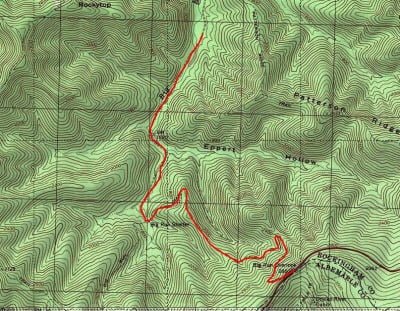
Here is the elevation profile of Big Run Loop:
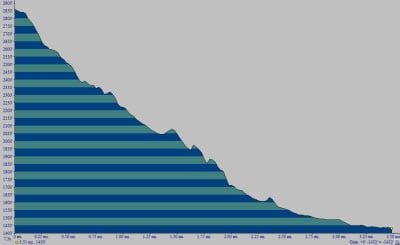
The Rocky Mountain Run trail is deceptive. It starts out on a gentle ridgeline moving west from the overlook and, while there are some switchbacks that you know will be brutal at the end of the day, it’s not that bad. But then you hit the concrete marker at the junction of Rocky Mountain Run trail, take a left and immediately know that you are in trouble. You can look at the elevation profile and see the dramatic story told by the steepness of the line in the first part of the profile. In short, the first mile and a half of this trail is brutal. Not from the sense of going in, but it puts a wedge in your mind about how bad it will be on the way back out. At the base of the sharp pitch, you pick up Rocky Mountain Run and get to see it metamorphose from a dry stream bed into a swollen stream. It does not become nominally fishable until you walk 2 miles from the overlook. From that point south to the confluence, it provides a tempting picture on those occasions where you can see it through the dense vegetation. I’ll discuss it in a different posting.
3.4 miles from the start, we rolled into the confluence. With the huge volume of water pushing into the junction from Big Run, we knew we were onto something. Continuing to trust the common wisdom that it is better farther downstream, instead of starting to fish here, we walked down on the broad Big Run Portal trail road until it crossed Big Run. There’s a great pool (picture below) and that forced us to stop walking and start fishing. I left Terry and Deb at that spot and pressed further north. In short order, the trail crosses a stream again. I could not stand it any longer and broke down to begin fishing. There was a great hatch going on of small brown bugs fluttering above the stream in a thick cluster that matched up nicely with either an Adams or a March Brown pattern. I started with a March Brown and immediately began getting hits. This was to set the tone for the entire day.
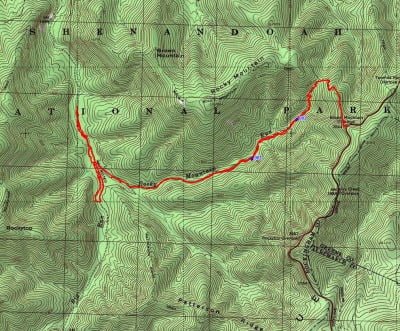
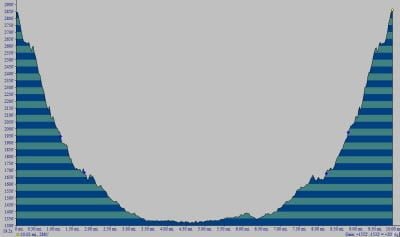
Big Run is full of fish. Unfortunately, many of them are small brook trout that come up and chatter at your fly without being able to ingest it. While I did catch a decent number of 6 to 8 inch brookies over the course of the day, it was pure torture to flip a fly out, get an immediate hit, and not be able to seal the deal. I fished my way up from the second crossing until I was 50 yards downstream from the stark cliff that I knew Terry was going to fish next. I returned to the crossing and hopped back on the trail to head north; all the while keeping an eye on the stream. In short order, the best pool of the day emerged through the vegetation on the left. I looped around to attack it from downstream and was grateful that I had my garden kneepads on to execute a cautious, low approach. I tried the dry flies but this pool was too deep to lure anything up from the protection gained by hugging the bottom. Based on that, I circled around to approach the pool from the upstream side and tied on a small Hares Ear nymph. Of course, the first time I flipped it out I got a big strike on the indicator. Geez! Resisting the temptation to switch back to dry flies, I continued to fish the nymph and was rewarded with a nice brookie just as Terry walked by on the trail; perfect timing! I sat in that spot for another 30 minutes and picked up two additional nice fish — one on a nymph and the next one on a large attractor pattern I eventually tied on to mimic my orange and green indicator.
Following that good experience, I continued north and rejoined Terry and Deb for lunch. Deb had not caught a fish yet — this was actually her first day of fly fishing after LL Bean instruction and practice — while Terry had picked up a decent sized brookie. As we chatted over lunch, we laid out the game plan for the rest of the day. My GPS indicated that we were 4.45 miles from the car and the threat of that brutal walk out was at the front of our minds. I recommended that they move downstream a little bit more since the water seemed to be getting better and work their way back upstream. I wanted to fish south from the confluence on Big Run to see if that would have been a better choice than walking north. With that, we parted and I returned to the first crossing where I fished my way back up to the confluence. This particular section of the stream is not good at all. It’s flat rock and shallow. While there are some decent fish where you can find a gravelly bottom, most of it is like a frying pan. As I emerged from the brush on the west side of the stream, I encountered another party of three fishermen at the confluence getting ready to attack the stream.
Small world story… this morning, before I sat down to write this, I got an e-mail from Charles asking me if I was the guy if he’d spoken with on the stream. It turns out he’s one of the readers of this blog and thought he recognized me from one of the rare “smiling fish” pictures that I periodically post. Anyway, we had a good anonymous chat on the stream. He told me that he had been here once before and that Rocky Mountain Run was generally flat rock that did not offer good holding structure for trout. In turn, I showed him the Adams and small indicator pattern that I was using (tied on as a double at that point). After our talk, I moved up Big Run to see what it had to offer. The flat water, staircase environment that existed just downstream from the confluence continued upstream for the next quarter mile. The stream doesn’t change until it takes a sharp turn to the east where it pounds into the steep hillside that leads up to Rockytop. I took a look at my watch and realized that I had to head back to rejoin the team since we decided to start walking out at 2 PM.
Crisis! When I rejoined Terry and Deb at the confluence, Terry had had “blowout” on his hiking boot. The entire sole was flapping loosely in the wind. We dug through my pack to find some Aquaseal that he applied to the sole and bound it with some parachute cord in hopes that it would get him out of the valley. Following the repairs, we headed east on the gentle trail that transitions from a level heaven to the gradual uphill purgatory and then the hell of the final climb. Halfway to the steep pitch, Terry’s other boot blew out and we applied Aquaseal to it as well. It only took another hundred yards before we realized that this solution was not going to work. I’d worn my hiking sneakers down to the first stream crossing on Rocky Mountain Run where I changed into my wading boots. Luckily, Terry’s shoe size was compatible, so I gave him those to wear on the remainder of the hike. That could’ve been a real rough walk out for him — visions of Valley Forge with T-shirts wrapped around his feet. I can describe the final pull out of the valley with a lot of words or a few. I’ll defer to a few words by saying — it was brutal. Tight switchbacks, steep pitch, seemingly endless.
Big Run Trout Fishing Bottom Line: Would I go back to Big Run? Unquestionably yes. Do I want to do it next weekend? Unquestionably no! This is a place every fan of brook trout should visit once they are in good enough shape to survive the trip. Did we make the right choice of approach? Would walking in from Big Run Overlook have been the better selection? I don’t know, and would welcome feedback from readers who’ve walked in using both trails. As I sit here on this bright, sunny Easter morning, I have to give thanks that my health and fitness are good enough for me to enjoy such a great place and encourage anyone in similar condition to make this trip.
Getting There: The Brown Mountain overlook is just north of milepost 77 on Skyline Drive.
Google Local Coordinates: 38.291958,-78.65756
Secrets Revealed? No. This is a very public location that is documented in the following places:
Virginia VDGIF
Flyfisher’s Guide to Virginia
Virginia Trout Streams
Virginia Blue-Ribbon Streams
Fly Fishing Virginia
Tell a friend about this article by clicking on this link
Date Fished: 4/3/2010
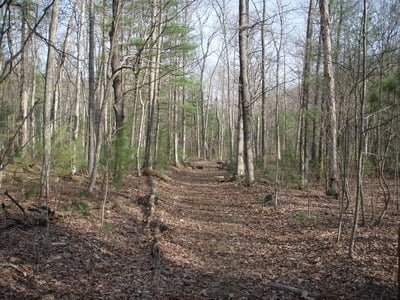
The Big Run Portal trail runs from the junction down to the Park boundary
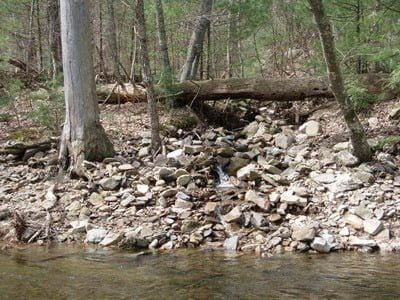
Big Run is fed by a large number of spring seeps and small feeder streams
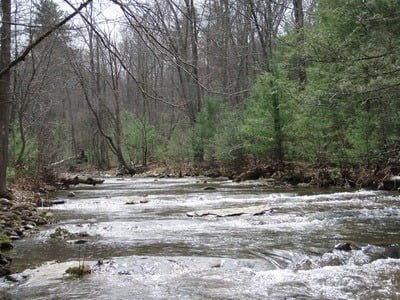
The area immediately downstream of the confluence is a dead zone of slick, flat rock, staircased in small gradient breaks
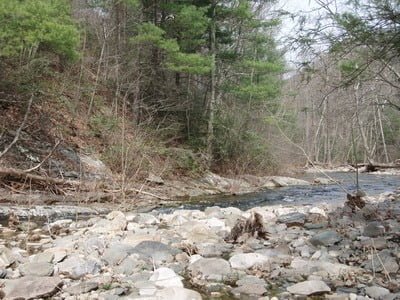
There is a deeper cut in this corner leading to the first crossing
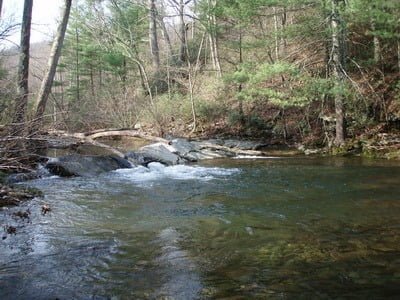
First stream crossing downstream of confluence – nice hole
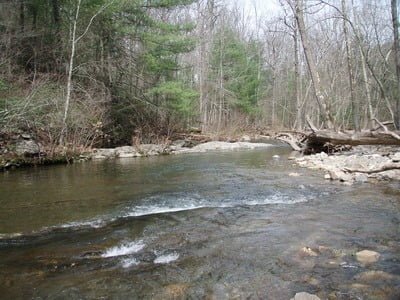
Upstream of stream crossing has some good spots before the staircase starts
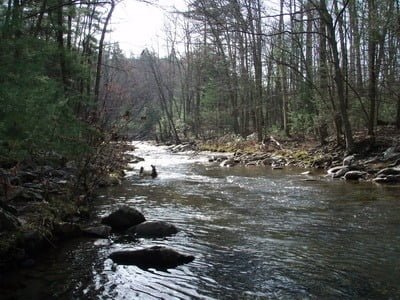
Upstream from second crossing – very productive
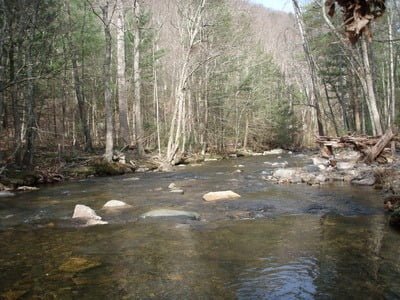
Downstream from second crossing – runs flat and shallow
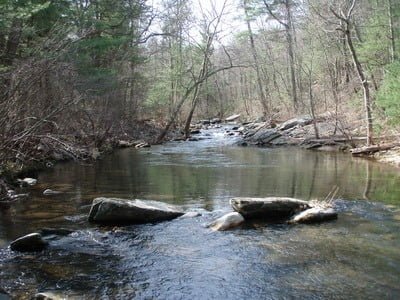
Farther downstream, you have your pick of deep pools. This is the best one I encountered
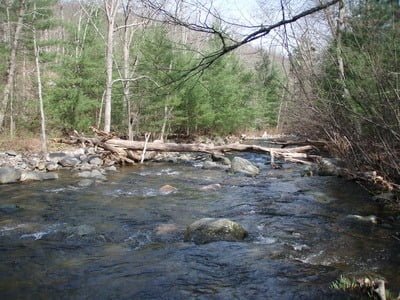
Each pool is separated by a faster run as the stream pushes towards the valley
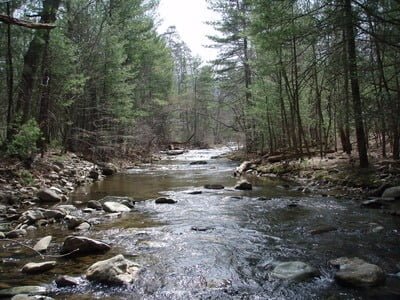
View upstream from the confluence – flat rock/staircase
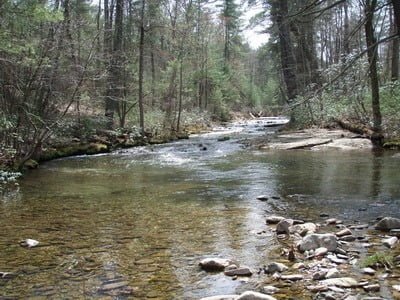
One decent pool in the middle of the staircase
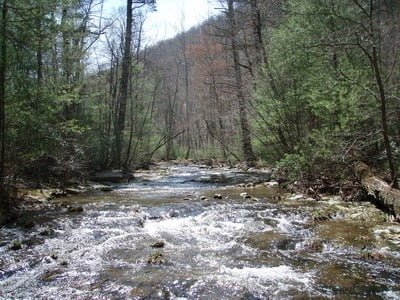
The water volume is not as high above the confluence since Rocky Mountain Run has not joined – stream spreads over flat rocks – runs shallow.
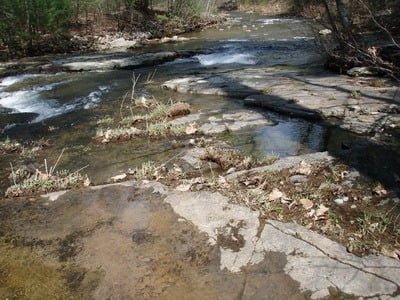
Visible flat rock structure
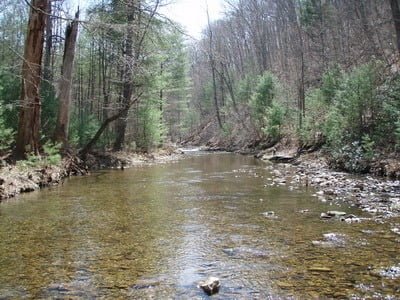
This slot is where I turned around – I walked up to the distant end to see the pool by the rapid.
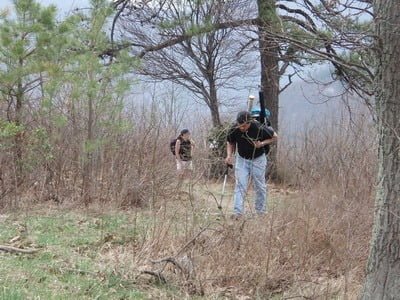
Deb and Terry lurching over the last climb to the parking lot… two 57 year old guys and a grandmother can make it… BUT… you need to be in shape!
Unless stated otherwise, this article was authored by Steve Moore


